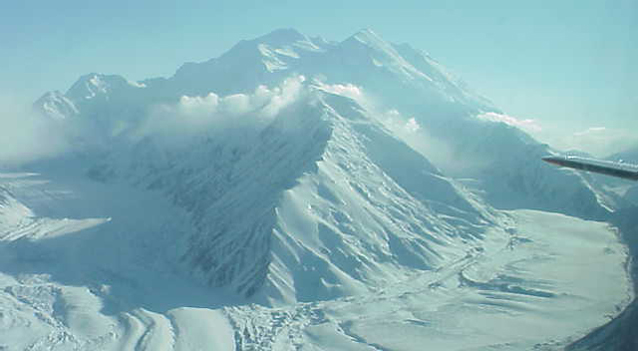
NPS Photo
The Muldrow Glacier cascades down a northern slope of Mount McKinley in view of visitors to Wonder Lake. While high in the mountains hides the Traleika Glacier, a tributary of the Muldrow. These iconic glaciers are known for their surging behavior. This behavior is a glacier's capacity to speed up and flow faster during an "active phase" before slowing down to a normal speed during a rest or "quiescent phase". These phases vary from surging glacier to surging glacier. An active phase can last for a few months to a few years while a quiescent phase can last decades.
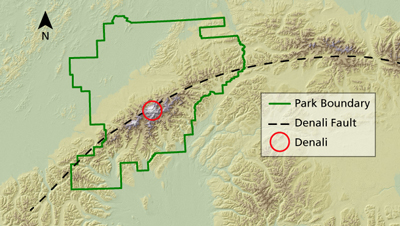
Surging is not common, but Traleika and Muldrow are among several glaciers in the Alaska Range that do so. The reasons that some glaciers surge and others don’t is only partly understood. In this case, it is likely because the Traleika and the Muldrow flow over the shattered, weak rocks of the Denali Fault.
A surging glacier may give the impression that it is expanding, but surging does not involve a significant change in the mass or volume of a glacier. Instead, surging is a change in the shape of the glacier. The change involves the rapid movement of ice from higher elevations of the glacier down towards the lower elevations. While this motion is occurring, several phenomena are evident:
- Rapid surface acceleration
- Greater than normal generation of crevasses and seracs
- A wave of thick ice that progresses downglacier until the completion of the surge
Once the surge finishes, repeat surveys show that the upper glacier has thinned, while the lower glacier has thickened.
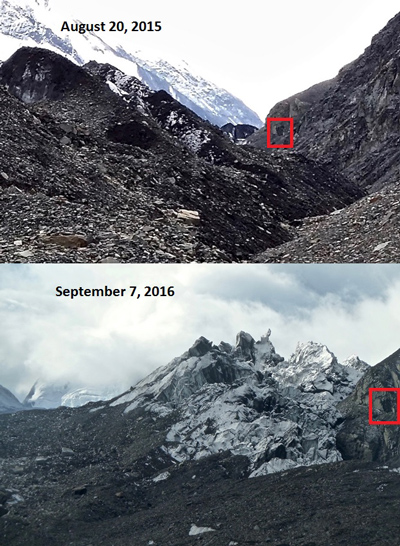
The Muldrow Glacier last surged in 1956-1957. Observers of the event believed it was initiated by an earlier surge on the Muldrow’s largest tributary, the Traleika Glacier. Glaciologist, Will Harrison, has speculated, based on an analysis of debris patterns on the glacier surface, that the Traleika/Muldrow system surges every 50 years or so. If he is right, we are due for another surge.
Our eyes and cameras are the traditional tools for detecting change. To the naked eye a surge appears as a zone of broken, crevassed ice sitting higher in the valley than it once did. During a Glaciologists made such an observation during a recent (September 2016) visit to Traleika Glacier. The area when compared with a similar photo from the year before, shows the Traleika Glacier has thickened and grown more crevassed.
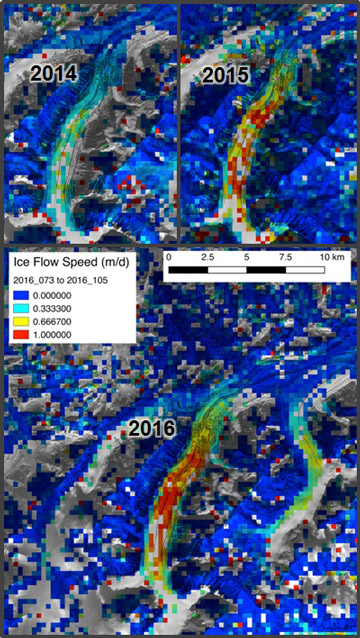
The tools glaciologists use to “watch” glaciers are changing, and we now have more evidence that a surge is underway. Repeat satellite images show surface velocities on Traleika Glacier accelerated in summer 2015, and even more so in summer 2016. Typical surface speeds on Traleika Glacier were 30-40 cm per day in 2014. By summer 2016 much of the Traleika Glacier was moving more than 100 cm per day. There is also a hint that the Muldrow Glacier may be speeding up at the confluence with Traleika. At present the evidence for such a speed-up is weak, and localized to the immediate area of the confluence.
Another tool glaciologists use is the global positioning system, or GPS. Repeat measurements of metal stakes left in the glacier surface allow us to estimate glacier velocities. These measurement confirm the observations described above from satellite data, and also help estimate changes in the surface elevation of the ice. Comparisons of measurements made in 2010 and 2016 show that Traleika is thickening in its lower elevations, upstream of the Muldrow confluence. The Muldrow is starting to thicken as well. The uppermost measurements on Traleika are negative, thought in 2015 they showed evidence of thickening—presumably from the earlier part of the surge. This suggests that the thickened “bulge” of the surge has already made its way past this location, and that we should expect to see the remaining surge activity downstream of this point.
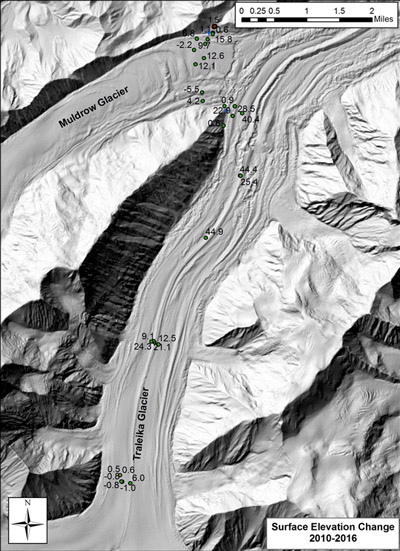
Glacier surges are one of the many ways that Alaska’s glaciers and mountains remind us that geology is not always slow. National Park Service and University of Alaska Fairbanks glaciologists will continue to watch the developing Traleika/Muldrow surge, and among other questions will be watching to see whether long-term shrinkage of these glaciers, resulting from gradual climatic warming, is having any effect on their surging behavior.
Last updated: March 16, 2021
